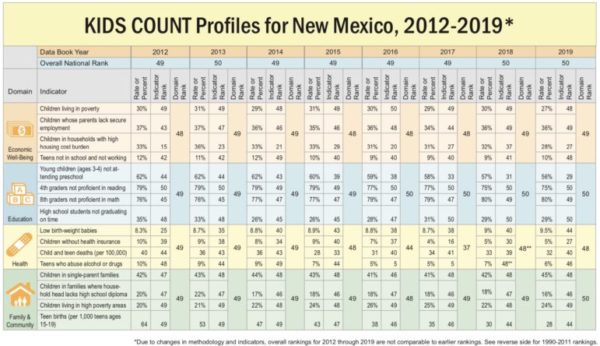That’s a stark ranking, the second year in a row New Mexico earned that distinction.
For detractors and supporters of former governor Susana Martinez, there’s a lot to digest in the numbers released Monday because they track with nearly her entire tenure.
The chart below shows the Kids Count rankings in several categories for 2012-2019, but most of the data comes from 2010-17 (Rankings go back to 1990, but a different methodology was used in those years, making direct comparison difficult).
“It very much is a reflection of what happened, and more specifically, what didn’t happen during the Martinez years,” said James Jimenez, executive director of New Mexico Voices for Children, which monitors the indicators for New Mexico.
“Fundamentally, the story the data tells is there was a real failure by the Martinez administration to invest in youth, children and families in a way that made much of a difference in terms of these kinds of rankings,” he said. Jimenez was chief of staff to Martinez’s predecessor, Democrat Bill Richardson.

Behind the numbers
It’s worth digging into the 16 categories to see where the state has been and where it’s going.
The report for 2012, based on data from Martinez’s first year in office, shows the state 49th in child wellbeing. In 2018 and 2019, New Mexico ranked 50th. But there are nuances within those numbers. There have been some important improvements that Martinez gets credit for, despite the overall trend downward.
Probably the biggest strides have been in early education, where the Legislature and governor increased access to preschool during lean budget years. When Martinez started, 61% of 3- and 4-year-olds did not attend preschool, for a ranking of 44. In 2017, that was down to 56%, and New Mexico jumped to 29th in the nation in that category.
Another high-profile action by Martinez was to accept Medicaid expansion under the Affordable Care Act, something many other Republican governors rejected at the time.
“The one area where she did do well in, and we give her credit for, is the Medicaid expansion. That had an immediate and dramatic impact on some of the health stats for our children,” Jimenez said.
That action cut the child uninsurance rate in half, from 10% down to 5%, with New Mexico zooming past 12 states in that area.
Still, two big areas that Martinez focused on — K-12 education and the economy — showed little sign of budging. Fourth-graders not proficient in reading went from 79% to 75%, with no change in ranking, and 8th-graders not proficient in math went from 76% to 80%, dropping New Mexico four slots to 49th. As for economic well-being, a slightly smaller percentage of children live in poverty, 27% in 2017. That rate fluctuated between 29% and 31% during her time in office. Other economic conditions have stagnated or gotten worse for families who struggle to access secure employment and affordable housing.
That’s despite Martinez’s push to diversify the state’s economy through tax incentives and a corporate tax cut in 2013.
“Clearly the trickle down approach didn’t work,” Jimenez said. “Tax incentives as a way to spur economic development as a general policy has almost always failed in our state and in our country.”
New Mexico In Depth has contacted former Gov. Martinez for an interview about the Kid’s Count numbers, but has not heard back.
However, on her legacy website, Martinez touted the increase in the number of students graduating from high school and college. “High school graduation rates have increased to an all-time high of 73.9% in K-12 public schools, with graduation rates for Hispanic and low-income students growing at a faster rate than the rest of the state,” the website said.
The site also touted Martinez’s use of a $50 million closing fund for economic development projects that created more than 8,000 new jobs.
Where to next?
Jimenez said to really move the numbers on child wellbeing in New Mexico would take a unified approach between the governor and Legislature. That was difficult to achieve during the Martinez administration, when the Republican governor and Democratic-controlled Legislature had different ideas about the way forward.
One thing that can help bring a cohesive approach to child wellbeing is the newly passed Early Childhood Education and Care Department, he said.
Gov. Michelle Lujan Grisham was a backer of the department, which will bring together all programs serving children from birth to age 5. Tripp Stelnicki, a spokesman for the governor, said interviews for a secretary to lead the department are taking place now.
“It will be a lot of work and a sizable investment to stand up this new agency, but well worth it when we deliver the turnaround New Mexico kids and families deserve,” Stelnicki said.
He also said the governor would take a comprehensive approach to improving child wellbeing, rather than “cherry pick” solutions.
Still, he said, Lujan Grisham did plan to keep pushing the Legislature aggressively on early childhood education. (Her attempts during the past legislative session to get money for preschool from the Land Grant Permanent Fund fell on deaf ears, though she did manage to get a hearing in front of the Senate Finance Committee, a first for the idea.)
NM Voices’ Jimenez said his group was pleased with the change in direction coming from the governor’s office, and saw two areas where the state could dramatically alter the trajectory for New Mexico’s children.
The first was in education.
“We’re pretty excited about the way they are speaking about culturally and linguistically appropriate education for our children. They’re not operating under the assumption that the national standardized tests ought to be the metric against which we measure children’s success,” Jimenez said.
He said the state should also shift its strategy from economic development to workforce development.
“What industry really needs is a workforce. We would recommend to the governor that. Let’s focus on ensuring we have the workforce a 21st century economy needs,” Jimenez said.
This article first appeared on New Mexico In Depth and is republished here under a Creative Commons license.


